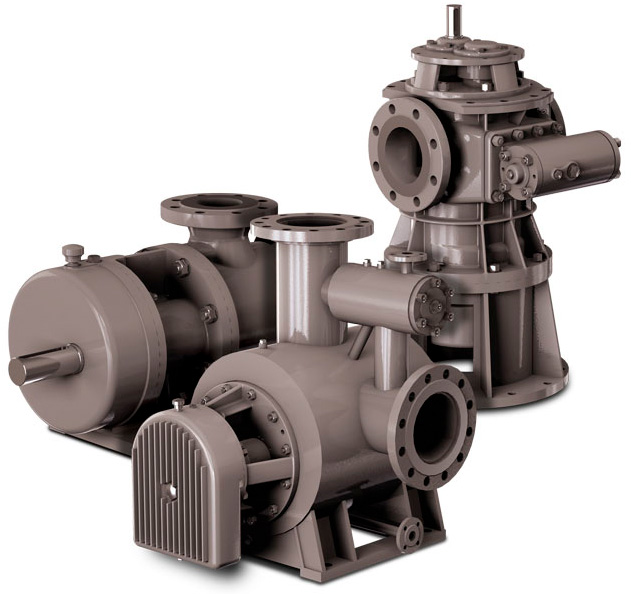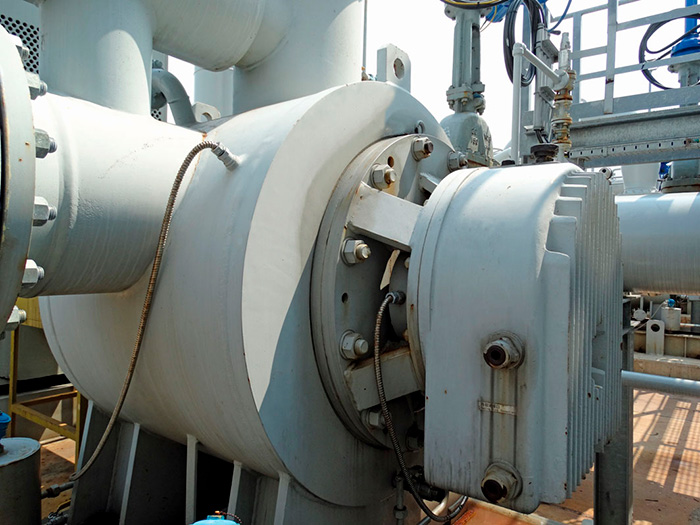The flow-rate, viscosity and efficiency advantages of screw pumps make them a viable alternative to centrifugal pumps.
The oil and gas industry is a complicated business that covers the discovery of underground reserves to their recovery, gathering, refining, manufacturing, transport, storage and eventual marketing. Throughout this massive production and supply chain, pumps are required to move fluids and gases to and from numerous points.
For many years, the pumping technology of choice in many fluid-transfer applications in oil and gas production has been centrifugal pumps, which have performed well in these situations. Their method of operation—fluid enters the pump impeller along or near to the rotating axis and is accelerated by the impeller, flowing radially outward into the volute discharge port—makes them well designed for the high-volume, severe-duty transfer applications that are common in the industry.
Centrifugal pumps also work especially well with thin, water-like fluids that must be transported through networks of piping with variable flow rates.
It can be easy to see why centrifugal pumps have gained a reputation as a go-to technology in oil and gas fluid-handling applications. Some operators even have an understandable “if it ain’t broke, don’t fix it” mindset when it comes to considering alternatives to centrifugal pumps in this industry. However, a different technology—positive displacement (PD) twin- and triple-screw pumps—can also be a versatile, reliable and efficient choice in the oil and gas industry.
One of the biggest challenges in making the screw pump more prevalent in oil and gas applications is convincing industry operators to try another technology. Generally speaking, the bulk of the fluids that are handled during oil and gas production in North America have very low viscosities and must be transferred at very high flow rates, which plays to the operational strength of centrifugal pumps.
Because centrifugal pumps have been successful in North America, other oil-producing regions of the world, especially the Middle East, have replicated the North American production infrastructure, including the significant use of centrifugal pumps.
In many cases, oil and gas production and processing systems have been designed around the pumping technology, rather than the other way around.
This means that engineers are first familiar with centrifugal pumps and attempt to work within their operational limits. They know how centrifugal pumps operate, know their benefits and are confident that they are the best technology for what they are trying to accomplish.

Image 1. Versatile twin and triple screw pumps can handle the many different fluid-handling applications encountered in the oil and gas production and supply chains. (Images courtesy of Blackmer)
However, PD screw pumps can be a viable alternative. Many engineers are not taught about screw pumps in their studies. Many who are aware of them have a preconceived notion of their shortcomings, or believe they are nothing more than lube pumps capable of handling only low flow rates.
Today’s screw pumps have experienced remarkable advancements in terms of the flow rates that they can handle, with flow ranges from 220 gallons per minute (gpm)—or 833 liters per minute (L/min)—to 11,000 gpm (41,635 L/min) not uncommon.
The design of PD screw pumps makes them capable of handling various liquids, even those with higher viscosities such as the crude oil that is being recovered in some areas of Canada and the rest of the world.
The pump’s operating principle sees opposed screws engaged to form a sealed cavity with the surrounding pump casing. As the drive screws turn, the fluid is shifted and steadily and constantly conveyed to the pump’s discharge port, which creates a volumetrically consistent flow rate regardless of the pumping pressure.
The list of benefits provided by screw-pump technology in oil and gas fluid-handling applications includes:
- Ability to handle a wide range of flows, pressures, liquid types and viscosities
- Constant flow, even in the presence of varying system backpressures due to viscosity changes
- High volumetric and overall operating efficiencies, resulting in reduced operational costs
- Controllable output via variable capacities
- Low internal velocities
- Self-priming operation and good suction characteristics
- High tolerance for entrained air and other gases—a prime consideration in oil production
- Low mechanical vibration lengthens service life
- Intrinsically smooth and quiet operation
- Extremely low pulsation reduces stress and prolongs life of associated fluid-transfer components (piping, hoses, etc.)
Realizing the operational advantages that can be achieved when using screw pumps in oil and gas fluid-transfer applications, some companies have developed products to meet these needs.
One screw pump product line offers twin screw with timing gear (WTG) and triple screw models for oil and gas fluid-transfer activities. The twin screw WTG pumps have been designed with external bearings and a timing-gear transmission, which produces double-suction, self-priming operation with no metal-to-metal contact between the pump’s internal components.

Image 2. These triple screw pumps are made to handle clean lubricating fluids without solid content across a wide range of viscosities, temperatures and pressures. This method of operation delivers smooth, constant product flow with low noise and high levels of energy efficiency.
This design helps the twin screw WTG pump achieve the highest flow rates of any rotary PD pump, even at varying backpressures and viscosity levels.
The deliverable flow rate of a PD screw pump increases as the fluid’s viscosity increases. These design characteristics also make screw pumps suitable for all types of transfer applications, including low- or high-viscosity, lubricating or non-lubricating, neutral or aggressive, and clean or contaminated fluids.
The triple screw pumps are made to handle clean lubricating fluids without solid content across a wide range of viscosities, temperatures and pressures. They are designed with a male drive spindle, two female secondary spindles and a case that contains the screws, which allows the fluid to move smoothly and continuously in an axial direction from suction to discharge. This method of operation delivers smooth, constant product flow with low noise and high levels of energy efficiency.
Familiarity can provide comfort in a world that seems to be changing much too rapidly. It can be easy to see why operators in the various segments of oil and gas production—upstream, midstream and downstream—have come to rely so heavily on centrifugal pumps for their fluid-transfer needs. It is a technology that has proven over many years to satisfy their demands in optimizing a very complicated production and supply chain.
Screw pumps can be an efficient, reliable and versatile alternative to centrifugal pumps in critical oil and gas fluid-handling applications.
Josh Pepper is the global product manager—screw pumps for Blackmer in Grand Rapids, Michigan. He may be reached at 616-248-9235 or josh.pepper@psgdover.com.
Michael Moore is Blackmer’s senior director, business development—screw pumps. He may be reached at 519-802-2106 or michael.moore@psgdover.com. For more information on Blackmer’s pumps and compressors, visit blackmer.com or call 616-241-1611. Blackmer is a product brand of PSG, a Dover company.